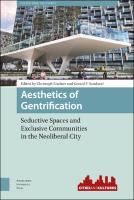Aesthetics of Gentrification
Seductive Spaces and Exclusive Communities in the Neoliberal City
Contributor(s)
Lindner, Christoph (editor)
Sandoval, Gerard (editor)
Language
EnglishAbstract
Gentrification is reshaping cities worldwide, resulting in seductive spaces and exclusive communities that aspire to innovation, creativity, sustainability, and technological sophistication. Gentrification is also contributing to growing social-spatial division and urban inequality and precarity. In a time of escalating housing crisis, unaffordable cities, and racial tension, scholars speak of eco-gentrification, techno-gentrification, super-gentrification, and planetary-gentrification to describe the different forms and scales of involuntary displacement occurring in vulnerable communities in response to current patterns of development and the hype-driven discourses of the creative city, smart city, millennial city, and sustainable city. In this context, how do contemporary creative practices in art, architecture, and related fields help to produce or resist gentrification? What does gentrification look and feel like in specific sites and communities around the globe, and how is that appearance or feeling implicated in promoting stylized renewal to a privileged public? In what ways do the aesthetics of gentrification express contested conditions of migration and mobility? Addressing these questions, this book examines the relationship between aesthetics and gentrification in contemporary cities from multiple, comparative, global, and transnational perspectives.
Keywords
Gentrification; urban development; visual culture; architecture; built environmentDOI
10.5117/9789048551170Publisher
Amsterdam University PressPublisher website
https://www.aup.nl/Publication date and place
2021Imprint
Amsterdam University PressSeries
Cities and Cultures,Classification
History of art
Architecture
City and town planning: architectural aspects


 Download
Download Web Shop
Web Shop